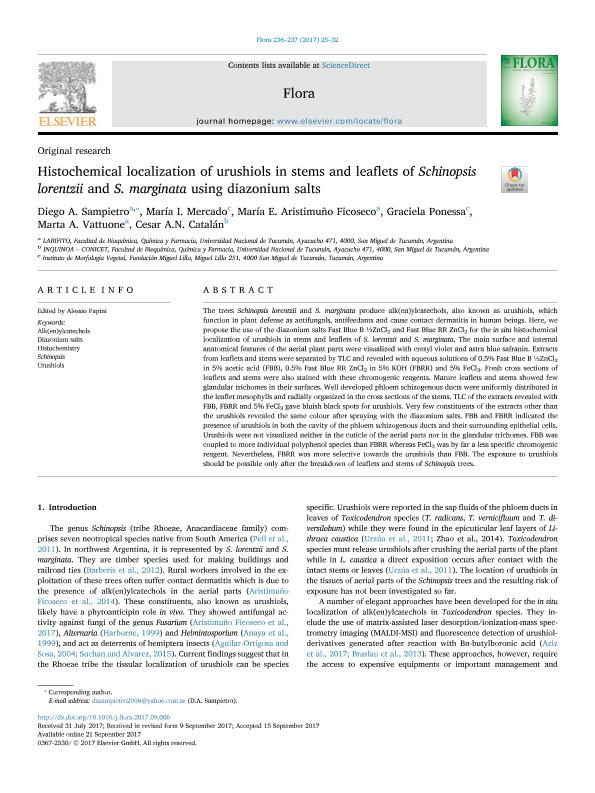Mostrar el registro sencillo del ítem
dc.contributor.author
Sampietro, Diego Alejandro

dc.contributor.author
Mercado, Maria Ines

dc.contributor.author
Aristimuño Ficoseco, Maria Eugenia del Milagro

dc.contributor.author
Ponessa, Graciela
dc.contributor.author
Vattuone, Marta Amelia

dc.contributor.author
Catalan, Cesar Atilio Nazareno

dc.date.available
2019-01-04T21:19:32Z
dc.date.issued
2017-11
dc.identifier.citation
Sampietro, Diego Alejandro; Mercado, Maria Ines; Aristimuño Ficoseco, Maria Eugenia del Milagro; Ponessa, Graciela; Vattuone, Marta Amelia; et al.; Histochemical localization of urushiols in stems and leaflets of Schinopsis lorentzii and S. marginata using diazonium salts; Elsevier Gmbh; Flora; 236-237; 11-2017; 25-32
dc.identifier.issn
0367-2530
dc.identifier.uri
http://hdl.handle.net/11336/67484
dc.description.abstract
The trees Schinopsis lorentzii and S. marginata produce alk(en)ylcatechols, also known as urushiols, which function in plant defense as antifungals, antifeedants and cause contact dermatitis in human beings. Here, we propose the use of the diazonium salts Fast Blue B ½ZnCl2 and Fast Blue RR ZnCl2 for the in situ histochemical localization of urushiols in stems and leaflets of S. lorentzii and S. marginata. The main surface and internal anatomical features of the aerial plant parts were visualized with cresyl violet and astra blue safranin. Extracts from leaflets and stems were separated by TLC and revealed with aqueous solutions of 0.5% Fast Blue B ½ZnCl2 in 5% acetic acid (FBB), 0.5% Fast Blue RR ZnCl2 in 5% KOH (FBRR) and 5% FeCl3. Fresh cross sections of leaflets and stems were also stained with these chromogenic reagents. Mature leaflets and stems showed few glandular trichomes in their surfaces. Well developed phloem schizogenous ducts were uniformly distributed in the leaflet mesophylls and radially organized in the cross sections of the stems. TLC of the extracts revealed with FBB, FBRR and 5% FeCl3 gave bluish black spots for urushiols. Very few constituents of the extracts other than the urushiols revealed the same colour after spraying with the diazonium salts. FBB and FBRR indicated the presence of urushiols in both the cavity of the phloem schizogenous ducts and their surrounding epithelial cells. Urushiols were not visualized neither in the cuticle of the aerial parts nor in the glandular trichomes. FBB was coupled to more individual polyphenol species than FBRR whereas FeCl3 was by far a less specific chromogenic reagent. Nevertheless, FBRR was more selective towards the urushiols than FBB. The exposure to urushiols should be possible only after the breakdown of leaflets and stems of Schinopsis trees.
dc.format
application/pdf
dc.language.iso
eng
dc.publisher
Elsevier Gmbh

dc.rights
info:eu-repo/semantics/openAccess
dc.rights.uri
https://creativecommons.org/licenses/by-nc-sa/2.5/ar/
dc.subject
Alk(En)Ylcatechols
dc.subject
Diazonium Salts
dc.subject
Histochemistry
dc.subject
Schinopsis
dc.subject
Urushiols
dc.subject.classification
Otras Ciencias Biológicas

dc.subject.classification
Ciencias Biológicas

dc.subject.classification
CIENCIAS NATURALES Y EXACTAS

dc.title
Histochemical localization of urushiols in stems and leaflets of Schinopsis lorentzii and S. marginata using diazonium salts
dc.type
info:eu-repo/semantics/article
dc.type
info:ar-repo/semantics/artículo
dc.type
info:eu-repo/semantics/publishedVersion
dc.date.updated
2019-01-02T18:31:11Z
dc.journal.volume
236-237
dc.journal.pagination
25-32
dc.journal.pais
Alemania

dc.journal.ciudad
Berlin
dc.description.fil
Fil: Sampietro, Diego Alejandro. Universidad Nacional de Tucuman. Facultad de Bioquímica, Química y Farmacia. Instituto de Estudios Vegetales. Cátedra de Fitoquímica; Argentina. Consejo Nacional de Investigaciones Científicas y Técnicas. Centro Científico Tecnológico Conicet - Tucumán; Argentina
dc.description.fil
Fil: Mercado, Maria Ines. Fundación Miguel Lillo; Argentina. Consejo Nacional de Investigaciones Científicas y Técnicas. Centro Científico Tecnológico - Tucumán. Unidad Ejecutora Lillo; Argentina
dc.description.fil
Fil: Aristimuño Ficoseco, Maria Eugenia del Milagro. Universidad Nacional de Tucuman. Facultad de Bioquímica, Química y Farmacia. Instituto de Estudios Vegetales. Cátedra de Fitoquímica; Argentina. Consejo Nacional de Investigaciones Científicas y Técnicas. Centro Científico Tecnológico Conicet - Tucumán; Argentina
dc.description.fil
Fil: Ponessa, Graciela. Fundación Miguel Lillo; Argentina
dc.description.fil
Fil: Vattuone, Marta Amelia. Universidad Nacional de Tucumán. Facultad de Bioquímica, Química y Farmacia; Argentina. Consejo Nacional de Investigaciones Científicas y Técnicas. Centro Científico Tecnológico Conicet - Tucumán; Argentina
dc.description.fil
Fil: Catalan, Cesar Atilio Nazareno. Consejo Nacional de Investigaciones Científicas y Técnicas. Centro Científico Tecnológico Conicet - Tucumán. Instituto de Química del Noroeste. Universidad Nacional de Tucumán. Facultad de Bioquímica, Química y Farmacia. Instituto de Química del Noroeste; Argentina
dc.journal.title
Flora

dc.relation.alternativeid
info:eu-repo/semantics/altIdentifier/doi/https://doi.org/10.1016/j.flora.2017.09.006
dc.relation.alternativeid
info:eu-repo/semantics/altIdentifier/url/https://www.sciencedirect.com/science/article/pii/S0367253017333157
Archivos asociados
